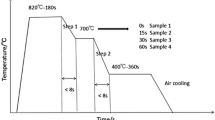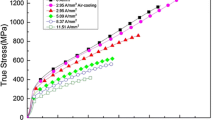Abstract
In the present study, the tensile deformation behavior of transformation-induced plasticity (TRIP)-aided steel under pulsed electric current is investigated. When a pulsed electric current is applied to the specimen during entire tensile deformation, a significant reduction of elongation is observed. The reason is that the mechanically induced martensitic transformation (MIMT) effect does not work properly as the stability of retained austenite phase increases due to temperature rise by the applied electric current. To improve the ductility of the TRIP-aided steel, the pulsing pattern of electric current is modified to apply the electric current only in the early stage of deformation immediately before the phase transformation of retained austenite phase begins to take place. As a result, the elongation is significantly increased by delaying the MIMT effect and making it work properly in the latter stage of deformation. Also, the electrically-induced annealing effect, which occurs in the early stage of deformation where a dislocation plasticity occurs dominantly, contributes to the improvement of elongation. The modified pulsing pattern suggested in the present study provides an easy-to-implement technique to improve the formability of the TRIP-aided steel.









Similar content being viewed by others
References
Friedrich, H. E., Steinle, P., Kopp, G., & Scholl, R. (2010). Next decades ‘Challenges for Terrestrial Vehicles’ materials and manufacturing to reduce CO2 emissions. Materials Science Forum, 3, 638–642.
Jimenez-Melero, E., van Dijk, N. H., Zhao, L., Sietsma, J., Wright, J. P., & van der Zwaag, S. (2011). In situ synchrotron study on the interplay between martensite formation, texture evolution and load partitioning in low-alloyed TRIP steels. Materials Science and Engineering A, 528, 6407–6416.
Jacques, P., Ladriere, J., & Delannay, F. (2011). On the influence of interactions between phases on the mechanical stability of retained austenite in transformation-induced plasticity multiphase steels. Metallurgical and Materials Transactions A: Physical Metallurgy and Materials Science, 32, 2759–2768.
Tirumalasetty, G. K., Huis, M. A., van Kwakernaak, C., Sietsma, J., Sloof, W. G., & Zandbergen, H. W. (2012). Deformation-induced austenite grain rotation and transformation in TRIP-assisted steel. Acta Materialia, 60, 1311–1321.
Girault, E., Martens, A., Jacques, P., Houbaert, Y., Verlinden, B., & van Humbeeck, J. (2001). Comparison of the effects of silicon and aluminium on the tensile behaviour of multiphase TRIP-assisted steels. Scripta Materialia, 44, 885–892.
Jacques, P., Furnemont, Q., Mertens, A., & Delannay, F. (2001). On the sources of work hardening in multiphase steels assisted by transformation-induced plasticity. Philosophical Magazine A, 81, 1789–1812.
Han, H. N., & Lee, J. K. (2002). A constitutive model for transformation superplasticity under external stress during phase transformation of steels. ISIJ International, 42, 200–205.
Han, H. N., & Suh, D.-W. (2003). A model for transformation plasticity during bainite transformation of steel under external stress. Acta Materialia, 51, 4907–4917.
Zackay, V. F., Parker, E. R., Fahr, D., & Bush, R. (1967). The enhancement of ductility in high-strength steels. Transactions of American Society for Metals, 60, 252–259.
Han, H. N., Oh, C.-S., Kim, G., & Kwon, O. (2009). Design method for TRIP-aided multiphase steel based on a microstructure-based modelling for transformation-induced plasticity and mechanically induced martensitic transformation. Materials Science and Engineering A, 499, 462–468.
Olson, G. B., & Cohen, M. (1982). Stress-assisted isothermal martensitic transformation: Application to TRIP steels. Metallurgical and Materials Transactions A: Physical Metallurgy and Materials Science, 13, 1907–1914.
Han, H. N., Lee, C. G., Suh, D.-W., & Kim, S.-J. (2008). A microstructure-based analysis for transformation induced plasticity and mechanically induced martensitic transformation. Materials Science and Engineering A, 485, 224–233.
Carlos, G.-M., & Francisca, G. C. (2005). The role of retained austenite on tensile properties of steels with bainitic microstructures. Materials Transactions, 46, 1839–1846.
Schubert, R. (2003). Warm forming—principles, applications, case study. Society of Manufacture Engineers, Technical papers, EM 87–129, pp. 1–15.
Troitskii, O. A. (1969). Electromechanical effect in metals. Pis'ma v Zhurnal Èksperimental'noi i Teoreticheskoi Fiziki, 10, 18–22.
Okazaki, K., Kagawa, M., & Conrad, H. (1978). A study of the electroplastic effect in metals. Scripta Metallurgica, 12, 1063–1068.
Conrad, H. (2000). Electroplasticity in metals and ceramics. Materials Science and Engineering A, 287, 276–287.
Ross, C., Roth, J.T. (2005). The effects of DC current on the tensile properties of metals. In Proceedings of the ASME Materials Division Roth 100, (pp. 363–372). New York: ASME.
Ross, C. D., Irvin, D. B., & Roth, J. T. (2007). Manufacturing aspects relating to the effects of direct current on the tensile properties of metals. Journal of Engineering Materials and Technology, 129, 342–347.
Kim, M.-J., Lee, K., Oh, K. H., Choi, I. S., Yu, H. H., Hong, S.-T., et al. (2014). Electric current-induced annealing during uniaxial tension of aluminum alloy. Scripta Materialia, 75, 58–61.
Tang, G., Zhang, J., Yan, Y., Zhou, H., & Fang, W. (2003). The engineering application of the electroplastic effect in the cold-drawing of stainless steel wire. Journal of Materials Processing Technology, 137, 96–99.
Kim, M.-S., Vinh, N. T., Yu, H.-H., Hong, S.-T., Lee, H.-W., Kim, M.-J., et al. (2014). Effect of electric current density on the mechanical property of ultra-high strength steels under quasi-static tensile loads. International Journal of Precision Engineering and Manufacturing, 15, 1207–1213.
Lu, W. J., & Qin, R. S. (2016). Stability of martensite with pulsed electric current in dual-phase steels. Materials Science and Engineering A, 677, 252–258.
Nguyen-Tran, H.-D., Oh, H.-S., Hong, S.-T., Han, H. N., Cao, J., Ahn, S.-H., et al. (2015). A review of electrically-assisted manufacturing. International Journal of Precision Engineering and Manufacturing-Green Technology, 2, 365–376.
Thien, N. T., Jeong, Y.-H., Hong, S.-T., Kim, M.-J., Han, H. N., & Lee, M.-G. (2016). Electrically assisted tensile behavior of complex phase ultra-high strength steel. International Journal of Precision Engineering and Manufacturing-Green Technology, 3, 325–333.
Magargee, J., Morestin, F., & Cao, J. (2013). Characterization of flow stress for commercially pure titanium subjected to electrically-assisted deformation. Journal of Engineering Materials and Technology, 135, 041003.
Magargee, J., Fan, R., & Cao, J. (2013). Analysis and observations of current density sensitivity and thermally activated mechanical behavior in electrically-assisted deformation. Journal of Manufacturing Science and Engineering, 135, 061022.
Kim, M.-J., Lee, M.-G., Hariharan, K., Hong, S.-T., Choi, I.-S., Kim, D. Y., et al. (2017). Electric current-assisted deformation behavior of Al-Mg-Si alloy under uniaxial tension. International Journal of Plasticity, 94, 148–170.
Jeong, H.-J., Kim, M.-J., Park, J.-W., Yim, C. D., Kim, J. J., Kwon, O. D., et al. (2017). Effect of pulsed electric current on dissolution of Mg17Al12 phases in as-extruded AZ91 magnesium alloy. Materials Science and Engineering A, 684, 668–676.
Park, J.-W., Jeong, H.-J., Jin, S.-W., Kim, M.-J., Lee, K., Kim, J. J., et al. (2017). Effect of electric current on recrystallization kinetics in interstitial free steel and AZ31 magnesium alloy. Materials Characterization, 133, 70–76.
Sprecher, A. F., Mannan, S. L., & Conrad, H. (1986). Overview no.49 on the mechanisms for the electroplastic effect in metals. Acta Materialia, 37, 1145–1162.
Boiko, Y. I., Geguzin, Y. E., & Klinchuk, Y. I. (1981). Drag of dislocations by an electron wind in metals. Zhurnal Eksperimental’noi i Teoreticheskoi Fiziki, 81, 2175–2179.
Molotskii, M. I., & Fleurov, V. (1995). Magnetic effects in electroplasticity of metals. Physical Review B, 52, 15829–15834.
Liu, X., Lan, S., & Ni, J. (2013). Experimental study of electro-plastic effect on advanced high strength steels. Materials Science and Engineering A, 582, 211–218.
Lee, S.-J., Lee, S., & De Cooman, B. C. (2011). Mn partitioning during the intercritical annealing of ultrafine-grained 6% Mn transformation-induced plasticity steel. Scripta Materialia, 64, 649–652.
Mahieu, J., Maki, J., De cooman, B. C., & Claessens, S. (2002). Phase transformation and mechanical properties of Si-free CMnAl transformation-induced plasticity–aided steel. Metallurgical and Materials Transactions A, 33, 2573–2580.
Williamson, G. K., & Hall, W. H. (1953). X-ray line broadening from filed aluminium and wolfram. Acta Metallurgica, 1, 22–31.
Ungar, T., & Borbely, A. (1996). The effect of dislocation contrast on x-ray line broadening: A new approach to line profile analysis. Applied Physics Letters, 69, 3173–3175.
Ungar, T., Dragomir, I., Revesz, A., & Borbely, A. (1999). The contrast factors of dislocations in cubic crystals: the dislocation model of strain anisotropy in practice. Journal of Applied Crystallography, 32, 992–1002.
Han, H. N., Lee, C. G., Oh, C.-S., Lee, T.-H., & Kim, S.-J. (2004). A model for deformation behavior and mechanically induced martensitic transformation of metastable austenitic steel. Acta Materialia, 52, 5203–5214.
Furnemont, Q., Kempf, M., Jacques, P., Goken, M., & Delannay, F. (2002). On the measurement of the nanohardness of the constitutive phases of TRIP-assisted multiphase steels. Materials Science and Engineering A, 328, 26–32.
Jacchin, K., & Beyer, B. (2000). Thermodynamical calculation of martensite start temperatures in the system FeCrMnNiC. Zeitschrift fuer Metallkunde, 91, 106–113.
Sundman, B., Jansson, B., & Andersson, J. O. (1985). The thermo-calc databank system. CALPHAD, 9, 153–190.
Olson, G. B., & Cohen, M. (1975). Kinetics of strain induced martensitic nucleation. Metallurgical Transactions, 6A, 791–795.
Lecroisey, F., & Pineau, A. (1972). Martensitic transformations induced by plastic deformation in the Fe-Ni-Cr-C system. Metallurgical Transactions, 3, 387–396.
Jones, S. J., & Bhadeshia, K. H. D. H. (1997). Kinetics of the simultaneous decomposition of austenite into several transformation products. Acta Metallurgica et Materialia, 45, 2911–2920.
Acknowledgements
This work was supported by the National Research Foundation of Korea (NRF) grants funded by the Ministry of Science and ICT (MSIT) (No. 2015R1A5A1037627 and No. 2018R1A2B6006856). H.N. Han and H.-J. Jeong were supported by POSCO research project. The Institute of Engineering Research at Seoul National University provided research facilities for this work.
Author information
Authors and Affiliations
Corresponding author
Additional information
Publisher's Note
Springer Nature remains neutral with regard to jurisdictional claims in published maps and institutional affiliations.
Rights and permissions
About this article
Cite this article
Jeong, HJ., Park, Jw., Jeong, K.J. et al. Effect of Pulsed Electric Current on TRIP-Aided Steel. Int. J. of Precis. Eng. and Manuf.-Green Tech. 6, 315–327 (2019). https://doi.org/10.1007/s40684-019-00060-1
Received:
Revised:
Accepted:
Published:
Issue Date:
DOI: https://doi.org/10.1007/s40684-019-00060-1




